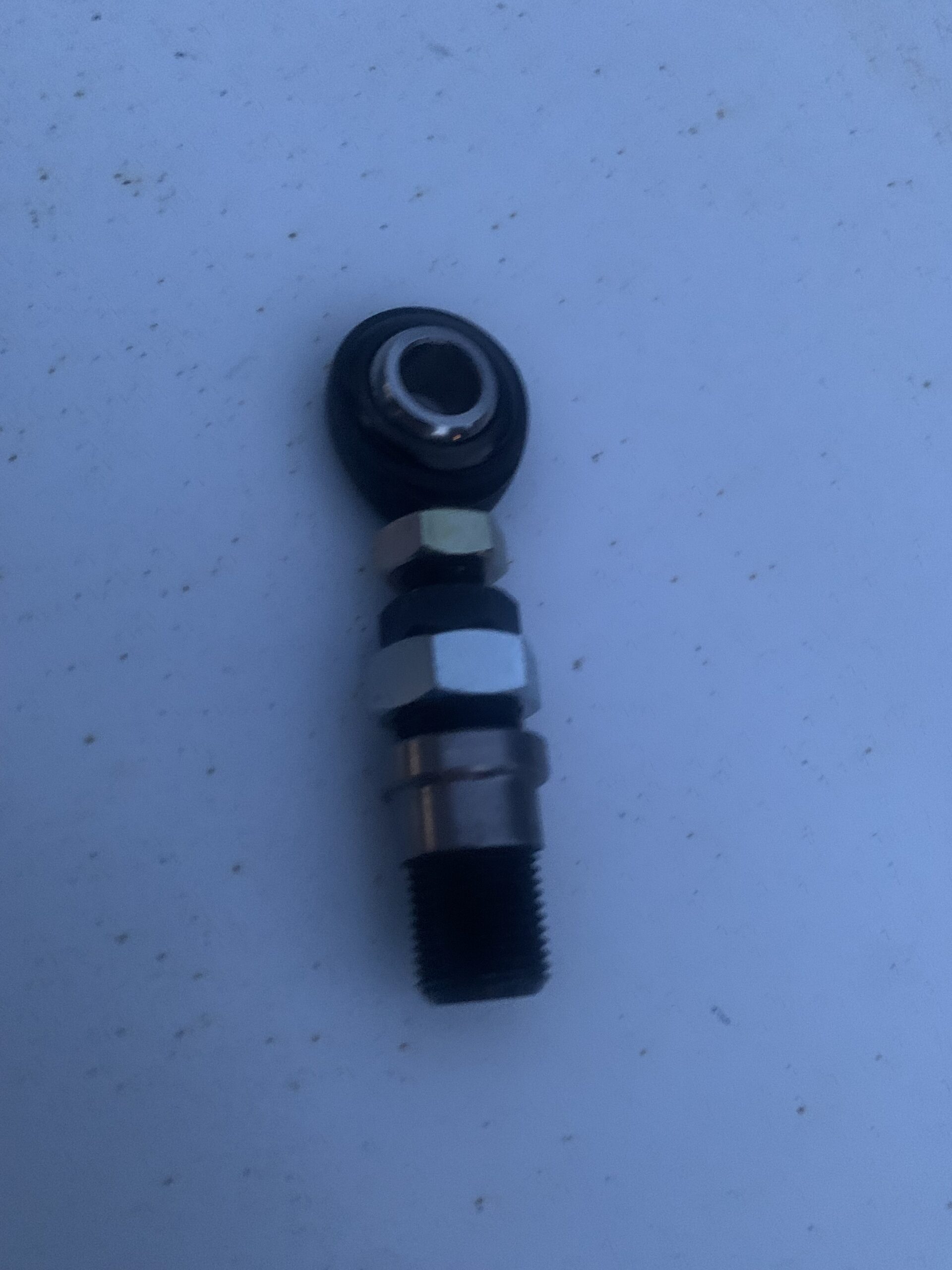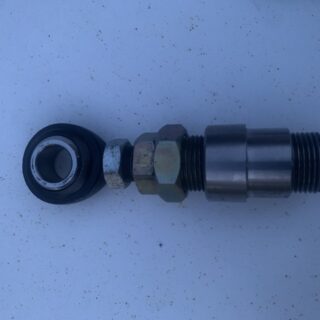When assembled these allow the adjustment of the center to center distance of a trailing arm or similar component without having to spin the tube itself while also not having to undo any mounting bolts. Helpful for swing arm type suspensions where the tube has a spring perch or bend that cannot be spun like many panhard bars.
These are also helpful when brake lines, sway bar linkage, or other components are mounted to the arm.
Additional uses like inner frame mounting of a-arms, wishbones, or otherwise where the component would usually need to be partially or mostly disassembled to adjust, are now on-car double adjustable.
Furthermore, many street cars benefit from a hybrid arm of sorts, with the end that sees the most articulation using a rod end, and the opposite end of the arm using a poly or rubber bushing to maintain NVH (Noise Vibration and Harshness) levels closer to most street driven cars.
Note that if used on an a-arm, wishbone, or similar they must be mounted parallel to one another, or the rod ends will spread apart or towards each other as they are adjusted. Keep in mind that if one is adjusted out and the other in they will grow away from each other as well, a small amount of flex built into either the arm or the mount is acceptable to absorb this misalignment.
Tech tip: If, for example, you are mounting a 1/2 rod end to a chassis bracket that takes a 12mm hole, the hole can be opened to 1/2 easily. Alternatively we highly recommend stepping up to 3/4 and using a high misalignment spacer/reducer, which not only allows the use of a higher strength rod end, but a larger range of travel. Ensure that the mount has enough width to accept the spacer, for example 3/4 reducer/spacers start at 1-7/8 wide. Yes, we can get inch rod end to metric fastener spacers.
Sold as a kit with the parts to do one tube end, parts can be omitted if you have tube bungs or rod ends already, message for adjusted pricing.
All kits include
-1x RH weld in tube end, available in limited tube diameters and wall thickness
-1x Steel double adjuster
-1x Moly PTFE rod end LH
-Steel jam nuts. 1 ea. for both the rod end and adjuster
The list below shows what tube ends are available.
*Keep in mind these tube ends come from several manufactures and two different sizes may not be visually identical. Other OD and wall thicknesses may be available, but not through our vendors*
1/2″ Rod End
-1.000″ .063″ wall
-1.000″ .083″ wall
-1.125″ .083″ wall (also available in chrome moly)
-1.125″ .095″ wall (also available in chrome moly)
-1.250″ .058″ wall
-1.250″ .065″ wall
-1.250″ .095″ wall (also available in chrome moly)
-1.250″ .120″ wall (also available in chrome moly)
-1.375″ .095″ wall (also available in chrome moly)
-1.375″ .120″ wall (also available in chrome moly)
-1.500″ .095″ wall moly only*
-1.500″ .120″ wall (also available in chrome moly)
-1.500″ .250″ wall (also available in chrome moly)
Additional rod end tech:
It is recommended when copying an arm to adjust both the tube and adjuster in until they bottom out, then 1/3 of their travel back outwards as your starting point or neutral point . Know your max dimensions as well and ensure you do not adjust beyond that. Minimum thread engagement is equal to thread size, meaning a 3/4″ rod end needs to be screwed into its female receiver a minimum of 3/4″.
We never use aluminum jam nuts, the weight savings of a few grams are forgotten when you round them and bust your knuckles.
We like thin steel jam nuts and include them on all 5/8″ & 3/4″ rod ends in all of our components.
Aluminum rod ends wear too quickly, and are not as strong.
Rod ends with greaseable bodies are not suitable for suspension components as the interruption in the cross section of the race for the grease fitting significantly reduces the strength. Grease attracts grit.
Continuing from above, grease will prematurely wear a rod end. Dry lubes such as the one we sell are the only thing that should be added.
There are rod ends with the high misalignment spacers built in, however they are significantly more expensive. When using a rod end with standard dimensions and added misalignment spacers your replacement cost is significantly reduced.
Teflon (PTFE) liners not only continually coat the ball with a nonstick surface, it also wipes the ball clean. This significantly adds to the life of the rod end. To date, with hundreds of rod ends sold, we have never had to replace a single one.
When mounting a rod end in single shear, some road racing sanctioning bodies require a large OD washer outboard of the rod end under the bolt head. This prevents a stretched race from slipping off the ball and the arm effectively breaking. Personally we have only encountered a race worn enough to stretch over the ball on aluminum rod ends.
Lined rod ends are noticeably tighter when new compared to a cheap rod end, the preload from the liner is what makes them last so long, cheap rod ends with a small amount of slack quickly turn into worn rod ends which will bind under load. We only use cheap rod ends for bolt in bracing for the misalignment, NOT for repeated articulation.
You may have come across implement rod end style linkage at farm supply stores, TSC lists them as “Adjustable Top Links”. These are used for the same reasons as above. A rigid linkage with some misalignment. Not something that can hold up to repeated articulation. The giveaway should be that the stems have coarse thread, and are made with a wide tolerance.
Expanding on the above, swaged tubes, also called “swedge tubes” are work hardened in the manufacturing process and become more brittle than the metal they are made from. 9/10 times this is not an issue, the 10th time is expensive. The biggest problem with tubes like these is that there is no wrenching flat.
Continuing, most steel tubes rely on a strong grip from the user to adjust, and when that fails a pair of vice grips, and after that a torch to burn the oxidation out. Obviously not ideal. We do not use any steel tubes other than steel hex tubes. Mostly eliminating this issue.
All adjustment threads in our finished components get a wipe of Permatex 37617 anti seize that comes in a glue stick type applicator. Much less mess than a brush top.
Know what your side to side travel is going to be throughout the articulation of the component. If you are making an A-B straight trailing arm, it may need a bend in it to re-center the stud and get the stem closer to perpendicular to the chassis fastener. You MUST be able to see some of the ball sticking out from the race, completely around the race, or else you are maxed out and will bend the stem.
In addition to the above example, if one end has a rubber or poly end, let its normal resting position be that it has no excessive force pulling it side to side at rest. IE, the bolt should go in and out without having to use force against the bushing. This will prematurely wear the material. A bend in the arm to re-center the bushing will be needed.
*NEVER* use a bolt or screwdriver through the rod end to spin it in to the tube if the threads are tight. If you do not have a tap, chaser, or bolt with a slit cut in it to chase the threads put a small adjustable wrench across the race of the rod end just under the ball to spin the rod end in. Using something through the bore will push against the race and crush it, squeezing against the ball. We consider them junk after this.
| Weight | 3 lbs |
|---|---|
| Dimensions | 6 × 6 × 6 in |
Only logged in customers who have purchased this product may leave a review.
Product Enquiry
Related products
-
Telescoping Adjustable Arm End – 3/4″ Rod End
$39.99Quick ViewAdd to cartWhen assembled these allow the adjustment of the center to center distance of a trailing arm or similar component without having to spin the tube itself while also not having to undo any mounting bolts. Helpful for swing arm type suspensions where the tube has a spring perch or bend that cannot be spun like …





Reviews
There are no reviews yet.